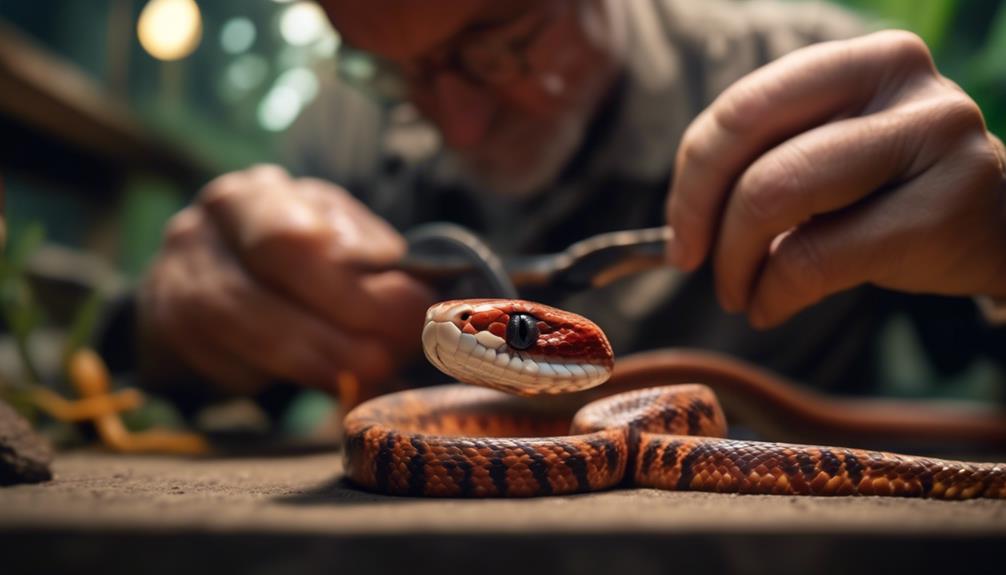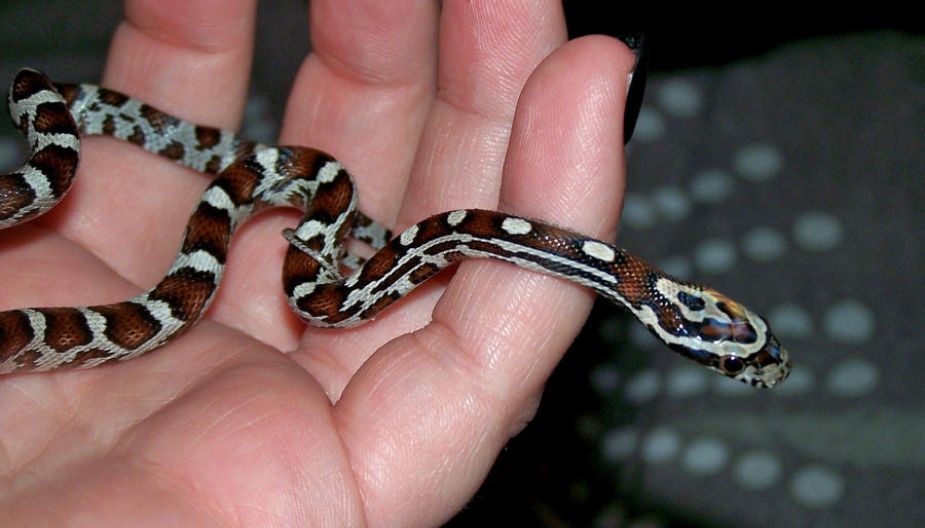For seasoned corn snake enthusiasts, the quest for advanced care tips is a commendable commitment. As you navigate the nuances of nurturing these remarkable reptiles, you may find yourself yearning for more.
But fear not, for there are additional avenues to explore in optimizing your corn snake's habitat, understanding their health, enriching their lives, fine-tuning their nutrition, and mastering advanced handling techniques.
These insights could be the key to unlocking a deeper connection with your serpentine companion, elevating your care to new heights.
Optimizing Habitat Conditions
To ensure optimal habitat conditions for your corn snake, regularly monitor and adjust temperature, humidity, and lighting levels in their enclosure.
Temperature gradients are crucial for corn snakes as they require a warm side (around 85°F) and a cooler side (around 75°F) in their habitat to regulate their body temperature effectively. You can achieve this by placing the heat source at one end of the enclosure.
Additionally, maintaining humidity levels between 40-60% is essential for proper shedding and respiratory health. Using a substrate that retains moisture, such as aspen shavings or coconut husk, can assist in regulating humidity.
It's important to provide hiding spots on both the warm and cool sides of the enclosure to help your corn snake feel secure. This can be achieved by using cork bark, half logs, or commercial reptile hides.
Understanding Health Monitoring
Regular health monitoring is crucial for experienced corn snake keepers to ensure early detection of any potential issues and to maintain the well-being of their snakes. Conduct regular check-ups by observing your snake's behavior, appetite, and overall activity level. Any sudden changes in these areas can be early indicators of underlying health issues.
Additionally, preventative care is essential in maintaining your snake's health. This includes maintaining proper hygiene, ensuring a balanced diet, and providing adequate environmental conditions.
Incorporating diagnostic tools into your health monitoring routine can also be beneficial. Thermometers and hygrometers can help you monitor temperature and humidity levels within the snake's enclosure, while regular weighing can help track the snake's growth and overall health. Keep a record of your snake's feeding schedule, shedding patterns, and any notable behaviors.
Lastly, it's important to be familiar with common health issues that may affect corn snakes, such as respiratory infections or parasites. Educating yourself on these potential issues will enable you to recognize symptoms early on and seek appropriate veterinary care when necessary.
Enrichment and Behavioral Stimulation
Enriching your corn snake's environment with various stimuli and activities is essential for promoting natural behaviors and mental engagement, contributing to their overall well-being and contentment. Behavioral enrichment and environmental stimulation are crucial for keeping your corn snake healthy and happy.
Here are some advanced tips for enhancing your snake's environment:
- Habitat Variety: Introduce different textures and objects into the enclosure, such as branches, rocks, and foliage, to encourage exploration and physical activity.
- Hiding Places: Provide multiple hiding spots of various sizes and shapes to mimic the snake's natural habitat, reducing stress and promoting a sense of security.
- Food Enrichment: Implement feeding techniques that encourage natural hunting behaviors, such as offering prey items with different textures and scents or using puzzle feeders.
- Environmental Changes: Periodically change the layout or introduce new items to prevent habituation, keeping the snake mentally stimulated and engaged.
Fine-Tuning Feeding and Nutrition
Enhancing the feeding and nutrition regimen for your corn snake involves careful consideration of dietary requirements and meal variation to ensure optimal health and vitality. When it comes to specialized diets, corn snakes thrive on a diet primarily consisting of rodents. However, offering variety in their diet can be beneficial. This can include occasional offerings of appropriately sized birds or lizard eggs. It's important to ensure that any prey items offered are appropriately sized, clean, and from a reliable source. Additionally, incorporating supplements like calcium and multivitamins can provide essential nutrients.
Consider the feeding frequency based on the age of your corn snake. While juveniles may require feeding every 5-7 days, adults may only need to be fed every 10-14 days. Always monitor your snake's body condition and adjust feeding frequency as needed. Here's a practical feeding frequency guide for corn snakes:
| Age | Feeding Frequency |
|---|---|
| Juveniles | Every 5-7 days |
| Sub-Adults | Every 7-10 days |
| Adults | Every 10-14 days |
Advanced Handling Techniques
Implementing advanced handling techniques for your corn snake requires finesse and patience, ensuring both the safety of the snake and your own confidence in handling. To take your handling skills to the next level, consider the following tips:
- Behavioral Observation: Continuously observe your snake's behavior to understand its temperament and mood. This will help you anticipate its reactions during handling and adjust your approach accordingly.
- Handling Sensitivity: Develop a sensitive touch by handling your snake regularly. This will allow you to gauge the appropriate amount of pressure to apply and minimize stress for your snake.
- Body Support: Always support your snake's body properly when handling to prevent it from feeling insecure or vulnerable. This can be achieved by using both hands to fully support its body and reduce the risk of injury.
- Confidence Building: Build your confidence gradually by starting with short handling sessions and increasing the duration as you and your snake become more comfortable. This will help establish trust and minimize stress for both you and your snake.
Conclusion
Now that you've mastered the basics of corn snake care, it's time to take your expertise to the next level.
By optimizing habitat conditions, understanding health monitoring, providing enrichment, and fine-tuning feeding and nutrition, you can ensure the best possible care for your snake.
But are you ready to take on the challenge of advanced handling techniques?
Keep pushing the boundaries of your snake keeping skills and watch your corn snake thrive like never before.


